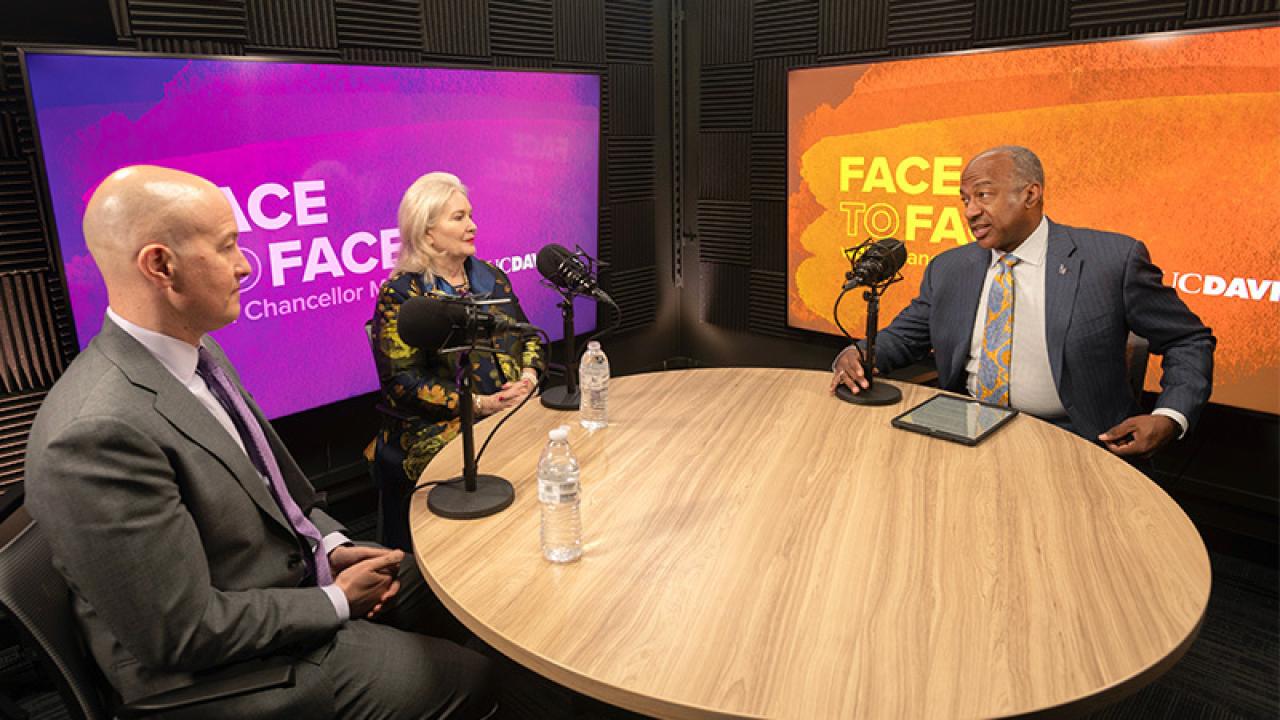
Checking In With Chancellor May: A Legacy of Innovation
To the UC Davis Community:
The power of innovation has fascinated me since I was a child. As I snapped Lego blocks together and assembled Erector sets, I was building the foundation of a career — first in engineering and now in higher education leadership — that seeks to create a better tomorrow.
Innovation has always been at the heart of our mission. Our campus was founded to make advances in agriculture and provide hands-on training for new generations of change-makers.
From our humble roots as the University Farm, UC Davis has grown into a world-renowned powerhouse of innovation. We helped pioneer the first plug-in hybrid electric venicle. We paved the way for food staples such as baby carrots and chardonnay grapes. The mechanical tomato harvester, invented at UC Davis, transformed the industry and allows ketchup to remain in plentiful supply. These are just a few UC Davis discoveries over the decades.
Our leadership and determination to create positive change continues to thrive. Last month, UC Davis hosted a national Council on Competitiveness summit, bringing together leaders in higher education, research labs and the workforce to discuss the future of place-based innovation.
During that time, I recorded a special episode of Face to Face With Chancellor May. My guests were Deborah L. Wince-Smith, president and CEO of the Council on Competitiveness, and Jed Kolko, undersecretary for economic affairs at the US Department of Commerce. We dug deeper into the roles that students, universities and companies play in sparking innovations and making them successful.
In particular, innovation doesn’t mean you have to be an entrepreneur or scientist to make important contributions.
“So much of innovation is the translation of ideas into the marketplace, into society,” Kolko said in our discussion. “And that work really needs people who are gifted visually and have a way with words and can be able to translate. So, to be the person who can translate what scientists are doing to the lawyers who are negotiating deals — that’s an incredibly important role in innovation.”
Hands-on experience
At UC Davis, we’re preparing students to lead the future of innovation by working hands-on with diverse teams. We support this mission by creating state-of-the-art facilities, such as the Diane Bryant Engineering Student Design Center (the grand opening will be May 5), providing the space and tools for leading-edge prototyping, manufacturing and fabrication.
We find so many UC Davis students who are eager to innovate. Students like Julia Mouat, a Ph.D. candidate in the College of Biological Sciences’ Integrative Genetics and Genomics Graduate Group, who won the UC Davis Grad Slam contest, for her presentation focused on the links between women’s smoking during pregnancy and the increased risk of autism in their grandchildren.
Or the GREEN-95 team, a group of UC Davis design students who, as part of a “Biodesign Theory and Practice” course in the design department, competed in two national innovation challenges to create a biodegradable face mask and reduce waste from landfills.
And, might it someday be possible to travel from San Francisco to Los Angeles in 30 minutes? Another student design team, OneLoop, in the College of Engineering, is testing this possibility and will showcase their work this summer at European Hyperloop Week 2023
I encourage all students to tap into their innovative spirit. The Undergraduate Research Center and the Mike and Renee Child Institute for Innovation and Entrepreneurship are full of resources and opportunities for students to get engaged with hands-on research.
About half of our undergraduates participate in hands-on research or design projects under the mentorship of professors. This level of student participation and faculty support far exceeds that of most other universities, where student research is largely confined to those pursuing graduate degrees.
Hands-on experience in research like this is crucial. It helps our students identify their interests and aptitudes. And it gives them experience that’s valued by employers and graduate schools.
The perfect mix
Innovation takes root when you find that perfect mix of people, place and ideas. For example, in January, UC Davis Health announced WellCent, the first start-up to be launched from its tech innovation incubator, which is also an Aggie Square partner. WellCent is working to transform at-home care through digital health technologies.
This kind of partnership is what Aggie Square is all about. It’s how we will propel economic development and build more resilient communities.
Aggie Square, by the way, will achieve a major milestone May 4 when we hold a “topping-off” ceremony for the first two buildings — commemorating the final structural beam of the framing. The engineer in me appreciates the tremendous work and vision it took to reach this point. Even more, I’m excited to see Aggie Square’s purpose continue to flourish, as we leverage our greatest strengths: academic excellence, multidisciplinary research, innovation and entrepreneurship.
The future is bright at UC Davis. As we open our campus doors to families this Picnic Day and introduce them to the wonders of science and the arts, who knows what future innovators, and hopefully Aggies, we will inspire.
I’m looking to spotlight students in future editions of “Checking In With Chancellor May.” Know of a student with an especially inspiring story who exemplifies UC Davis values? Let us know here.
Sincerely,
Gary S. May
Chancellor